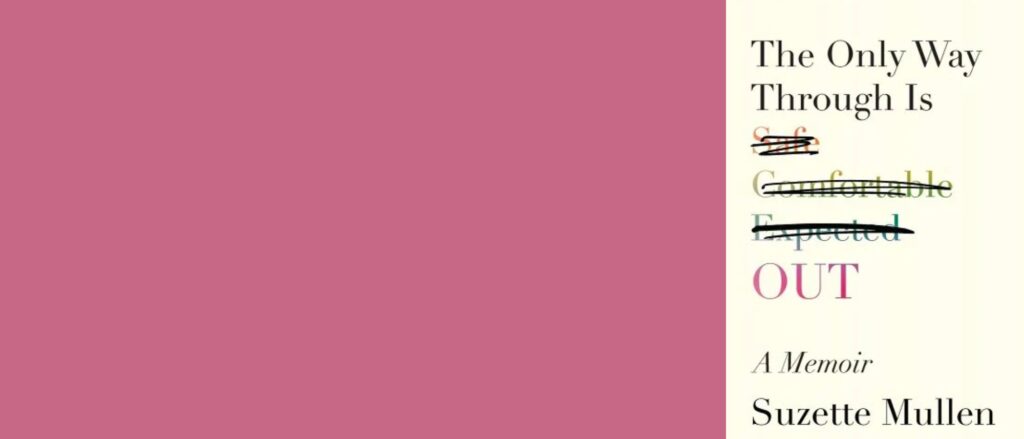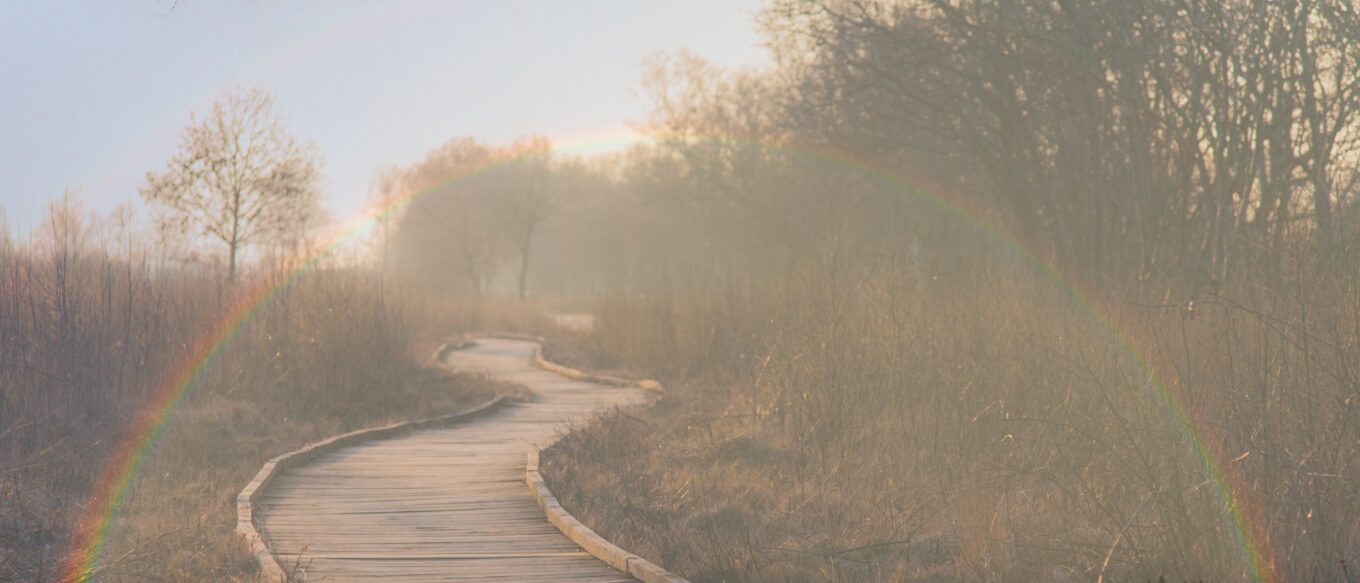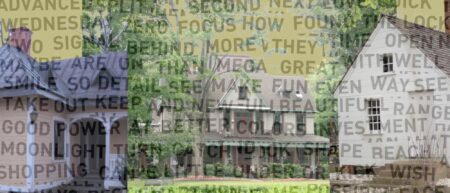Suzette Mullen’s memoir, The Only Way Through Is Out (University of Wisconsin Press 2024), is a coming-out and coming-of-age—at middle age—story of pushing away from what’s safe into the unknown. I first met Suzette in 2018 at Hippocamp, a creative nonfiction writing conference in Lancaster, Pennsylvania, and I have followed the progress of her memoir from that time to its publication last month. Suzette and I sat down together on Zoom to talk about how she stepped off the straight path of her life and onto the winding one that became her memoir, the challenges that came with making meaning from events still so fresh, and the importance of beginnings, both in life and in writing. Our interview has been condensed and edited for length and clarity.
Megan Reilley: When we first met, you were drafting The Only Way Through Is Out. While reading the finished book, I was surprised to learn that you were working on another memoir before you came out to yourself. Tell me about that.
Suzette Mullen: I was working on a memoir titled What Do You Do? about my professional journey and my struggles to create a professional life that aligned with who I was. Everyone asks that “what do you do” question when they first meet someone, and it was really challenging and sometimes painful for me to answer. My first career was as an attorney, but after I left law and became a stay-at-home mom, I spent decades searching for professional purpose. I felt that there were others—particularly women—who had perhaps not achieved the professional lives that they were hoping to, and I really wanted to dig into the question of what it means to find professional purpose. While I was working on the first draft of that book, I was led to a different story, one that upends my entire life. So it’s a bit meta—I was working on a memoir and through that memoir I came to uncover a truth about myself that was deeply buried, and then I lived that story and wrote about it in The Only Way Through Is Out.
MR: How did you switch your writing brain from one memoir to another? Many writers are familiar with discovery as part of the writing process—we start writing one story and it becomes something we hadn’t anticipated—but how did you handle a complete change of direction? Are your two memoirs somehow linked or did you start over?
SM: This published memoir is completely different from the first memoir. What’s interesting is that though I wrote two very different stories about two very different experiences, I discovered as I was writing The Only Way Through Is Out that some of the same themes were showing up in both stories. I could see that my professional struggles—or my inability to create a professional life that felt aligned with who I was—were really part of the same issue that had kept me in deep denial about who I was personally. These struggles were coming out of a life where I had been trained to play it safe. I had been making safe choices, which showed up in my professional life and in my personal life. There are some snippets and scenes that made their way from the first memoir into this memoir, but really more as context and background.
MR: How did the process of pulling material from the first book into the new one come together?
SM: Early iterations of The Only Way Through Is Out had quite a bit more of what had been in the first memoir. As I revised, I really pared down the old content, and only kept what was serving the story I was telling in the second memoir. We know about killing our darlings—I had a lot of superfluous material that didn’t end up making the cut in the final draft.
MR: Is there anything specific that you wish you could have included but didn’t, because you couldn’t find a way for it to serve the current story?
SM: Yes! And so I created a free resource that I call “Behind the Scenes,” which is an insider’s guide to The Only Way Through Is Out. I took five deleted scenes and analyzed why I wrote them in the first place and why they ultimately didn’t make it into the final version. It includes some takeaways for writers to think about in terms of revision. It was really fun to put together. I also repurposed some material into essays, newsletters, and blog posts. People have asked me if I’ll ever go back to the first story and write that book. I really don’t know, but if I do, it will be a very, very different book. I have lived a whole other life, and I understand that first story very differently than I did when I wrote it.
MR: Time and experience have a way of doing that to the work. How did you make decisions about where to position certain aspects of your story? For example, you chose to open the book with a few sentences from a scene you describe fully later on, in which you experience a very strong internal voice that is compelling you to touch a woman—your son’s kindergarten teacher. We eventually learn that it happened many, many years in the past. How did you envision the function of that moment in the narrative? Clearly, it’s a monumental element of your story and you probably could have placed it in a number of spots. But you chose to lead with it.
SM: Deciding what we open with is so challenging and so hard. I open the book with just a couple of lines, almost like a mini prologue, to make the reader curious. The full scene comes later in the book, and it is the very writing of that scene that becomes a pivotal moment in the book.
The first fully fleshed-out scene depicts my “before”—where I’m situated, the life I have—and opens with a question, “Could you think of one friend you would trade lives with?” My philosophy on memoir is that the protagonist starts with some kind of question about themselves, their life, their situation, or the world, and that question is answered or resolved by the end of the book. At the time my book opens, my friends appear to be stepping fully into their lives, and I long for that so deeply. But I don’t understand why that’s not happening for me. And so the journey (or question) in the book is to understand what was holding me back from living fully and making the decision to change my life so that I could finally live with my arms open.
MR: One of the threads that shows the journey to change your life is your connection to the kindergarten teacher, who becomes your dear friend. Throughout the book you are trying to understand your relationship to her and with her, and to undo the tangle of both of your lives, as they have become enmeshed in myriad ways—volunteering, business partnerships, mutual friendships, and the parent-teacher relationship. Your feeling inexplicably drawn to her is the catalyst for you to try and understand who you are. I enjoyed watching that thread unspool. It felt relatable.
SM: We have all had experiences that we immediately know are important, but we don’t have the language to describe those experiences at the time. I wanted my book to connect broadly with readers’ own experiences (in this case, the confusion of not having language to describe something). An experience like this doesn’t have to be about sexuality. It could be anything. It was through the writing process that I began to understand what that moment with the kindergarten teacher really was about, and that realization is what sets in motion the story I tell in this memoir.
MR: I saw my own experience in the three-sentence mini prologue and immediately I thought, Oh, I’ve had an experience like that. I wonder what happens? Interestingly, in your book you learn—and the reader learns—that the moment doesn’t lead where you thought it was going to lead. It leads to something unexpected. On page 4, you have a great line that ripples through the whole book: “Stories have many beginnings. This is one of mine.” I was struck by how true I know that to be. What guided you as you decided what beginnings were important to talk about in this story?
SM: As I reflected on my childhood, I realized that I’d experienced a sort of imprinting that set in motion a life in which I was afraid to make mistakes. I was afraid to take risks. I was afraid to be myself. I wrote the vignette you mention on a retreat years ago during which we were asked to spend a little time in silence and then write down our earliest childhood memory. That memory is the first of several beginnings in my book.
MR: Many writers struggle with understanding how to make sense of all the beginnings while also trying to convey meaning. I know I do. My memoir in progress includes childhood, midlife, and present day, and sometimes it feels as though I may never figure out how the pieces fit together. It’s the worst jigsaw puzzle I’ve ever had to work on. How did you figure it out? What was that process like for you?
SM: Structure, structure, structure! Structure is so hard. What shows up on page 1 is hard. What shows up on the last page is also difficult, because with memoir, your story continues. So where do you end it? That was a pretty easy question for me to answer, because I had a clear ending that tied the whole story together. Still, the middle wasn’t easy. It was messy. I went through many drafts. As a memoir writer, I needed to first get clear on the “story present”—the timeline of the primary story. Cheryl Strayed’s hike on the Pacific Crest Trail is her story present. But of course she’s flashing back throughout the book. My story present starts in 2012 and ends in 2017. Anything relevant that happened before the 2012 scene on page 1 has to be woven in somehow to the story present. My story present is told mostly chronologically, which is typical, unless you’re writing a memoir in essays or using an experimental form. My narrative arc has a beginning, middle, and end.
Fitting in all the other pieces involved a lot of trial and error. I had all kinds of spreadsheets where I was tracking different themes and storylines. The manuscript that I pitched to the University of Wisconsin Press required a relatively substantial revision after peer review. What’s on page 1 now was not on page 1 when I pitched the book. The truth is, we’re never really done. You have to be done because you have to send your book off. Recently, when I read a portion of my manuscript for my local writing group, I was thinking, Oh, I wish I had put that in a different place. If I had another shot at this, I would probably still mess around with it. We’re never completely there.

MR: I’m happy that you brought up your writing group. We met at a writing conference in Lancaster, a city which features prominently in the fourth part of your book. When we met, you had just moved to Lancaster. You still couldn’t believe you had done it. What role did finding your community—not only your LGBTQ+ community, but also your writing community—play in this memoir and in getting it over the finish line?
SM: Any writer knows, nobody writes a book alone. I have really been fortunate to have multiple writing communities. I’m a book coach and part of a wonderful community of other book coaches, many of whom are also writers. I leaned on them a lot, and I hired book coaches at different stages to help me get it to the finish line. My Lancaster writing community has a casual monthly meetup. We bring snacks and wine. We chat and talk about what we’re working on. Then we write in silence for an hour, and chat some more. It’s not a critique group. It’s about taking yourself out of that solitary writer’s life. I also have two writer friends who live in other parts of the country and we’ve been meeting virtually every month for almost ten years. Writing community is key.
I learned some very important lessons as I worked on my memoir within these communities, and I would offer two pieces of advice to anyone contemplating a big change in their life. These pieces of advice may sound contradictory but they actually complement each other. The first is you need to learn to trust what you’re hearing inside yourself. I really wanted other people to tell me what was the right thing to do because I feared making a mistake. Leaving my safe, comfortable life for something unknown and completely different was terrifying. If it was a “mistake,” it was a hell of a mistake! It took me a long time until I could trust myself.
The second is to find your community. I didn’t have that community for a good amount of the time during which I was struggling. That struggle is recounted in the book. My whole world was heterosexual. It’s not that heterosexual people can’t be supportive, it’s that some of those people weren’t able to understand what I was going through. I came to a city where I knew exactly one person, and found community almost instantaneously. That felt miraculous to me, and it struck me as being a sign from the universe.
MR: Another community integral to the book was secret and online, and it was where you first connected to the LGBTQ+ friends who would support you on your journey to understand yourself. You call them the LaLas in your memoir. Part of my own memoir deals with the experience of parenting one of my children through a gender transition, and I found a community of other parents of trans kids in a secret Facebook group, too. I had to be invited into it. The people who are in those spaces are looking for a confidential, safe place to be vulnerable and learn. How did you decide what to share from your experience with the LaLas and did you feel that you had to get permission from the community to share it? How did you respectfully and safely incorporate that space and the people you met there into your book?
SM: This later-in-life LGBTQ+ support group was central to my story, and I could not have told my story without it. I was careful to respect the privacy of the group. In some cases, I paraphrased conversations and changed identifying details, including names. There were about 50 women in the group when I joined, and when the group disbanded five years later, it included more than 2,000 women from all over the world. One of the rules was not to use the actual name of the group outside of the group itself. Through a post in the group, I shared that I was writing this book and that I wanted to reference the group but needed a different name. People responded to the post, brainstormed names, and “LaLas” emerged as the winner.
MR: The LaLas group was the very first place where you found a space to be yourself. What has that meant to you, personally and in terms of writing this book?
SM: Before I found the group, I did not know a single person who was on the other side of coming out later in life or who was questioning. Now, that feels laughable. But when you are going through a situation in which you feel so alone in your thoughts and feelings, finding a group like the LaLas can be a lifesaver. I dedicated my book to the LaLas and to every human who is longing to live out loud but is afraid of the cost. I wrote my book for them.
MR: That really speaks to me. I remain in the group that was such a source of support for me. I see new moms come in, having just learned that their child is trans and not knowing what to do with that. They’re scared. They don’t know how it’s going to affect themselves or their families or their child. They have fears for their child and the trajectory of their child’s life. They have fears about their relationships with their partners or the other parents of their children. All the same concerns and fears that I had when I found myself there years ago. I imagine you might feel, like I do, that your role has shifted. Instead of being the one coming into that space saying, Oh, my God! I don’t know what to do. This is happening in my life, and I’m scared, you instead are holding the hands of these other folks who may feel as if they are about to blow up their lives. By remaining in that space and others like it, you foster the community that embraced you on your journey. And it is as you said before: one reason that motivates me to continue working on my memoir is that I know this is never going to end. There will be parents whose children are trans. And they do not know it yet, and when that moment happens for their family, they’re going to want comfort and to know that things will be okay. It seems to me that is what your book is doing. Your story is letting people know that it’s possible to do hard, scary, and overwhelming things, and that joy is possible on the other side. It’s an extension of what you found in that digital space with the LaLas.
SM: Yes, in real life I do feel a responsibility, and it’s also a joy and a privilege to be able to let these people know that I see them. I was them. I understand. My book is for anyone who is examining their life or contemplating a big change. My journey to the other side wasn’t easy—there is a cost to choosing authenticity—but joy awaited me there. It’s never too late to make a change. It’s never too late for a new beginning. It’s never too late to write a new story for yourself.
Suzette Mullen (she/her) is a memoir and nonfiction book coach, retreat leader, and author. Her essays have appeared in the New York Times, today.com, and Brevity, among other outlets. Through Your Story Finder, Suzette focuses on amplifying the voices of LGBTQ+ writers and allies as she guides them to find their deeper stories and define their big ideas. Suzette is a graduate of Harvard Law School and Wellesley College. Her memoir, The Only Way Through Is Out, was published in February 2024.



